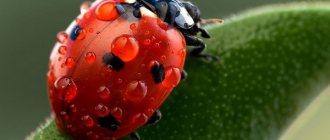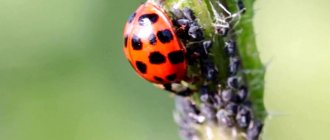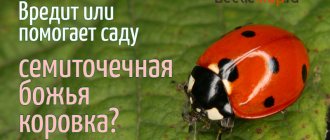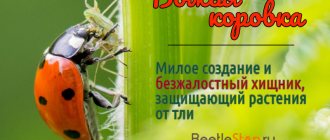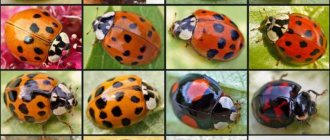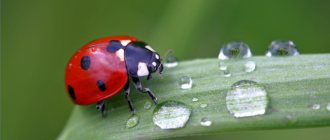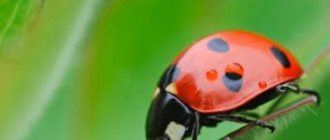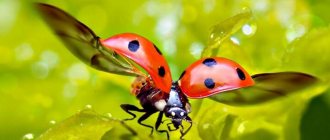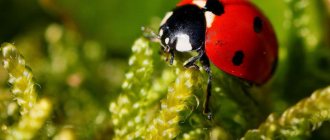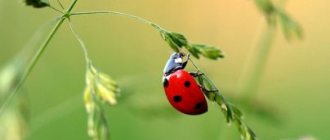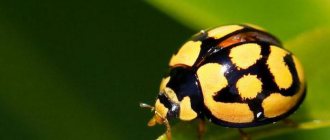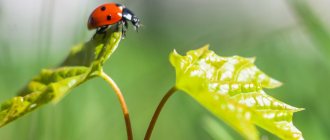Ladybug (lat. Coccinellidae) belongs to the family of beetles, a type of arthropod, a class of insects. When a person sees an insect, he involuntarily has a reaction - to slam it as quickly as possible, but the ladybug evokes sympathy in almost everyone, even women. Some remember a children's song associated with her, others remember that she really helps them out at their summer cottage - saving the garden from pests. What is the secret of everyone's sympathy for this beetle? In some cultures it is forbidden to kill a ladybug, and in the Western part it is generally considered a symbol of good luck. In many countries it is even included in the Red Book. Let's consider the characteristics and lifestyle of this insect, as well as the benefits and harms it can bring.
What does a ladybug look like?
Today, no more than 200 insect formations have been studied on the planet, but the number of species is limitless. The ladybug is a representative of the Coccinellidae family, has over 4000 types and 360 genera, and belongs to the order Coleoptera of the arthropod type. A distinctive feature from other relatives are the seemingly three-part legs. This is due to the small third segment, which is visually hidden with half of the fourth pedicle in the sinus of the bilobed process.
The average size of a ladybug is from 4 mm to 10 mm. The structure of the body is rounded, ovoid, flattened below and convex above. Sometimes the surface is covered with thin fibers.
The head is monolithically connected to the prothorax, everything looks like an enlarged cephalothorax. It makes up the main part of the body length, sometimes found in an elongated oval shape. The eyes are relatively large. The antennae are well flexible and consist of 8-11 segments.
Has rigid expressive elytra. Essentially these are the front flight organs. Over time, the ladybug's wings transformed. On the ground they perform a protective function. With the help of two rear processes, it flies, and it turns out quite well. It is interesting that various birds and many vertebrates do not dare to hunt it not only because of its toxicity. They do not have time to catch it, because the insect makes about 85 strokes per second.
Why is the ladybug called that?
Where did the ladybug get its name? The question remains open to this day. Scientific terminology is Coccinellidae, the word itself comes from the Latin meaning “scarlet”. Many ethnic groups have their own versions of names, for example:
- among the Germanic peoples - “the bug of the Virgin Mary”;
- among the Anglo-Saxons - “Lady bird”;
- among the Slavic - “Sun”;
- among Latin Americans - “St. Anthony’s cow”;
- among Asians it is “red-bearded grandfather”.
There are long-standing legends about why the ladybug is called that, let's look at some of them.
She was personified with the heavenly herd of Perun, connected the omnipotent gods and mortal people, and was credited with magical abilities to influence the weather. The Catholic faith considered her a messenger of the Mother of God. The British also associate their names with the Virgin Mary.
The ancient Slavs considered her the messenger of the sun. It was impossible to drive away the heavenly creature, so as not to turn away fortune. A beetle that flew into a home was considered to bring peace and grace, so they called it that way - “Sun”. The very word “God’s” symbolized among the Russian ethnic group a trusting believer. The beetle was compared to a harmless creature.
But more likely the word “lady” is associated with a physiological feature of the insect. It secretes milk, but it is far from usual - a red aggressive liquid formed in the spores of the limbs. The discharge is extremely unpleasant and in large quantities is deadly for those who decide to eat it. And another similarity with a cow is the presence of spots on the body.
Types of ladybugs
The ladybug is not necessarily red, but its coloring is in the form of dots. The dots may be absent altogether, and instead of them, stripes, patterned spots, or comma-shaped spots may appear on the shell. The most common type is the seven-spotted beetle. It lives almost throughout Europe, its dimensions reach 7 mm, the elytra are burgundy, there are two light-colored spots at the base, one dark one can be seen on the pronotum, with speckles on the elytra.
They are also divided according to the number of dots and color:
- two-spotted, usually 5mm dark scarlet individuals with 2 large black markings;
- twelve-pointed up to 6 mm, have pinkish elytra, on which 6 pieces are observed;
- thirteen-spotted up to 7mm, with brownish wings;
- fourteen-spotted - with a yellow color and black spots on them or vice versa;
- seventeen-point identical colors ranging from 2.5 to 3.5 mm;
- variable, with a black pre-back with 2 brownish spots, contrasting markings at the base of the yellowish-red elytra;
- blue ones are found on the Australian mainland and have a beautiful tint of blue and green tones;
- white or light gray - up to 15 marks, less common, like brown plain ones.
Stethorus
Stetorus is the closest “relative” of the ladybug: both beetles belong to the same family. However, in appearance they bear little resemblance.
Stetorus is a small bug (its maximum length is only 1.6 mm) and black. However, despite its tiny size, it copes with the destruction of pests “excellently”. Stetorus uses spider mites as food. During its existence, the bug eats at least 2000 ticks. For this reason, Stetorus is also called the tick ladybird.
Stetorus larva. Photo from scontent.ces.ncsu.edu
Before using chemicals to control spider mites, carefully inspect the plant. Perhaps tiny stetorus beetles are already operating there and they will cope with ticks without any “chemistry”.
Bright warning coloration of a ladybug
The ladybug is endowed with bright colors, which help in the struggle for existence and strike fear into enemies, most often birds. This is one example of mimicry, like the green color of grasshoppers, or the ability of a chameleon to blend into its environment for the purpose of self-preservation.
The striking colors of the natural wild world serve as warning signals about the toxicity and inedibility of the observed prey. There is a theory that the brighter the color of the beetle, the less likely it is to be attacked by enemies. The expressive color of various types of ladybug indicates mortal danger. It may fade with age.
Relationships with ants
Ants also protect aphids from cows. The relationships between aphids and ants are complex and not yet fully understood. Ants feed on honeydew secreted by aphids, which can make up up to half of their diet. It’s not without reason that they say about ants that they “milk” aphids. At the same time, the ants try to regulate the number of aphids, maintaining an optimal density of settlements. Ants zealously protect settlements from enemies.
Aphids are protected the more carefully the closer they are to the anthill and the fewer in number they are. By caring for aphids, ants can cause indirect harm to various crops, in particular, garden and cotton plantings. Usually the ants use it to drive away the cows, but sometimes they kill them. Thus, according to the observations of V.V. Yakhontop, during the massive artificial saturation of cotton fields in Central Asia with brumus cows, introduced there to combat cotton aphids, many cows died precisely from the ants.
Along with this, the magnificent ladybird (Coccinella magnifica) enjoys the protection of ants and exterminates aphids around anthills with impunity. But there are no true myrmecophiles (“cultivating” ants) among the cows, and termitophiles are very rare and are found only in Central America. But the main difficulty in feeding the aphidophagous ladybirds lies in the sharp decline in the number of aphids in the summer; the ladybird larvae die en masse from starvation.
Where do ladybugs live?
Ladybugs live almost all over the world, except in northern latitudes. Their life cycle depends on the availability of food. The active stage occurs during the extermination of aphids, the main diet of these insects, i.e. from spring to autumn. They live from a couple of months to one year, and occasionally last up to two. Able to survive winter in foliage or under the bark of trees.
A solitary lifestyle is acceptable to them; they settle in groups for wintering or for mating. They feel comfortable in open areas with grassy vegetation on forest edges, steppes, meadows and gardens.
In search of food, they crawl through plants, periodically flying over long distances. They do this easily, silently, working all day, destroying pests. Cows are thermophilic, the optimal temperature for them is +10 C and above; during other periods they spend the winter.
Ecological plasticity
Intraspecific ecological plasticity—this simple “adaptive strategy”—turned out to be sufficient to populate vast spaces. The same spot ladybird is found in the taiga zone, in mixed and deciduous forests, steppes and deserts throughout almost the entire Palearctic, rising high into the mountains, and in India it has reached the tropical zone. In Africa, its settlement stopped at the desert, the climate of which was too dry for it. Other reasons that favor the survival of cows include the toxicity of their blood to many animals. And the bright and motley warning color helps the predator, once flattered by the ladybug, not to repeat the unpleasant mistake. Therefore, cows only in very rare cases become victims of other predators.
Cows are an interesting example of species that have managed to spread widely and reproduce using precisely the primitive features of their structure: their sense organs, which serve as characteristic indicators of the level of evolution in insects, are poorly developed. Their movements are quite slow, they cannot run fast, fly well, or catch prey, as many other predators do. And yet they are numerous everywhere and thrive precisely because of their weak specialization.
A number of features in the particular way of life of ladybugs - high ecological plasticity, the ability to concentrate in small areas, the ability to devour a large number of aphids, mites, scale insects during their mass reproduction - determine the prospects for an even wider use of these natural human assistants in crop protection. The success of such use depends to a large extent on further in-depth study of their lives and behavior.
How and where do ladybugs overwinter?
When cold weather sets in, sedentary varieties of ladybirds gather in large groups, sometimes up to millions of individuals. In winter, they look for secluded places, hiding under the remains of falling leaves, dry wood, stones, where they wait for the arrival of warmth. They can fly indoors, hide between window frames, folds of curtains, and arrange nesting sites among trees.
There are species of beetles that fly away in flocks to winter in southern latitudes. Recently, features of adaptation to the environment have become not only bright colors or toxic liquid released when dangerous. Their group aggregations are becoming more and more observed. This is still inexplicable, but the spectacle is colorful.
If you find a “sleepy colony” of cows, do not disturb them and bring them home to warm them up. Think about how many pests they will be able to kill in the future. Move them to a comfortable place where no one will crush them, let them calmly complete their hibernation.
What do ladybugs eat? Are they predators?
A characteristic feature of insects of the order Coleoptera is the gnawing type of mouthparts. The ladybug has similar anatomical characteristics. The structure of the digestive system begins with the mouth and ends on the abdomen with the anus. The intestinal canal runs between them. This allows the insect to consume complex molecular food with a high energy reserve when feeding.
Simply put, the coccinellid is a predator; it eats its own kind. Diet preferences are given to:
- aphids;
- spider mites;
- small caterpillars;
- eggs of butterflies, Colorado beetles;
- larvae of insect pests.
There is also a species that feeds on plant foods: pollen, flowers and leaves, mycelium, and fruits.
Titles
The larvae of some groups of animals have special names. Usually, when talking about a species of animal, without specifying the stage to which it belongs, or when talking about a species as a whole, the name of the adult form is used, for example: “butterflies are an order of insects with complete metamorphosis.”
| Larva name | Animals |
| Insects | |
| Caterpillar | Butterflies (Lepidoptera) |
| false caterpillar | Sessile bellies (Symphyta) |
| Nymph | All insects with incomplete metamorphosis - hemipterans, orthoptera, mantises, dragonflies, etc. |
| Wireworm | Click beetles |
| Other invertebrates | |
| Glochidia | Freshwater mollusks of the pearl mussel (Unionidae) and pearl mussel (Margaritiferidae) families |
| Trochophore | Free-swimming (planktonic) larvae of a number of marine animals. They have several rows of cilia that aid in feeding |
| Nauplius | A type of larva in many crustaceans that uses head appendages for swimming |
| Vertebrates | |
| Tadpole | Tailless amphibians |
Sawfly larva Tenthredo marginella (false caterpillar)
Reproduction of ladybugs
Ladybugs reproduce several times a year, in spring or autumn. In temperate latitudes this is the beginning of May. The female becomes sexually mature at the age of 3-6 months. As a rule, after a cold period, she is able to emit a pungent odor that attracts males.
The female places eggs on vegetation with an abundance of aphids, providing food for future offspring in advance. They have an elongated shape, narrowed towards the end, and are colored yellowish-orange. One clutch can number from several to 400 pieces, arranged in even rows, close to each other. Sometimes they can be eaten by their own relatives, the so-called cannibal larvae.
Ladybug larvae - what do they look like?
Further development occurs over 4-7 days and has several stages. The larvae are oval in appearance. They look colorful due to yellow-orange spots that form a certain pattern. Body surface with bristles, peculiar outgrowths. Newborn ladybugs that feed on scale insects are covered with whitish, waxy threads. Everything grows in 2-4 weeks.
After this stage comes the moment of pupation. To move into it, the individual attaches the back of the body to the leaf plate and curls into a semi-bent position. At the end of the internal transformation, the skin peels off the pupa, sliding like a stocking to the end of the abdomen. It does not lose its bright color with black and yellow specks. Next, from 7 to 10 days, an adult is formed.
The benefits and harms of ladybug
The boundless gluttony of this predatory beetle brings great benefits to homesteads and agricultural crops, because it eats aphids that harm the crop. While in the larval stage, the coccinellid consumes up to 50 prey per day. An adult insect eats up to 100 aphids. They help plants by clearing crops of pests. Therefore, they are even bred at specialized enterprises, and then distributed over the fields with the help of aviation.
But harm can be caused by herbivorous species of these beetles; their habitats are in Asia. There they cause significant damage to crops. In our area, some harm vegetables: potatoes, sugar beets, tomatoes and cucumbers.
Development ways
Ultimately, the cows were presented with two options: either retain the ovipositor and the ability to lay eggs in favorable conditions, but with low fertility, or lay eggs in batches on random objects, thereby losing the ovipositor, but sharply increasing fertility. The first path was “chosen” by cows that feed on coccids, ticks and other invertebrates, the population numbers of which change relatively little and smoothly over the season. The second way turned out to be more profitable for most aphid eaters, which have complex development dynamics, usually with sharp spring and autumn peaks of reproduction and a large decline in summer. This path turned out to be beneficial for herbivorous ladybirds.
After the first diet, the larva begins to hunt. However, neither she nor the adult insect have any abilities for this purpose. Although all cows and their larvae are sighted, they do not see food, even close up, do not smell or guess it, and are able to eat it only after they accidentally come across it and feel it with their palps. All this makes it difficult to find the victim. Another difficulty is the temperature regime. Although hunting can last around the clock, for most species activity begins at temperatures above 10°, and even then at a slow pace, and stops at temperatures of 30-35°. Thus, the range of favorable temperatures is small. At the same time, even desert species require relatively high humidity and are inactive if the air is too dry.
